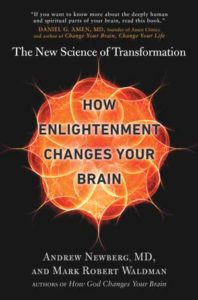How Enlightenment Changes Your Brain: The New Science of Transformation
Reviewed by Phila Hoopes
August 1, 2017
 By Andrew Newberg and Mark Robert Waldman. Avery, 2016. 288 pages. $26/hardcover; $17.99/paperback; $12.99/eBook.
By Andrew Newberg and Mark Robert Waldman. Avery, 2016. 288 pages. $26/hardcover; $17.99/paperback; $12.99/eBook.
Buy from QuakerBooks
“Based on our scientific evidence, I now believe that the stories found in sacred texts describing Enlightenment are real in that they are related to specific neurological events that can permanently change the structure and functioning of the brain.”
How many of us have rebelled against Descartes’s severance between the physical brain, its workings, and our most mystical experiences? Authors Newberg and Waldman have pursued this question in How Enlightenment Changes Your Brain, exhaustively measuring a broad range of spiritual experiences in an equally broad range of subjects via functional magnetic resonance imaging (fMRI) and single photon emission computed tomography (SPECT).
But ultimately they are pursuing a deeper goal: to define the elusive nature of the enlightenment experience—ranging from the “small-e” enlightenments of insights and eurekas that yield a flash of awareness but then recede without long-term effect, to the “big-E” life-changing mountaintop experiences of oneness with the Universe and the Divine.
Through surveys, interviews, and lab experiments with subjects spanning a range of religious traditions, the authors identify the common points of small-e enlightenment experiences:
- instant illumination of difficult problems
- immediate interruption of worries, fears, or doubts
- deepened kindness, compassion, and empathy
- increased open-mindedness and tolerance
- deep sense of peace
Large-E experiences build on this foundation with the following:
- a sense of unity or connectedness
- an incredible intensity of experience
- a sense of clarity and new understanding in a fundamental way
- a sense of surrender or loss of voluntary control
- a sense that something—one’s beliefs, one’s life, one’s purpose—has suddenly and permanently changed
The authors detail their studies of the effect of mediumship and channeling supernatural entities; the effect of healing prayer and ritual on the person praying and the recipient; the effect of praying at different intensities; and the effect of enlightenment on anger and conflict, to name only a few. Their studies encompass a broad spectrum of spiritual traditions, from Brazilian psychic mediums, Buddhist monks, Franciscan nuns, and Sufi dancers to atheists and non-practicing members of a faith. In one particularly fascinating encounter, they explore the impact of dogma, cognitive dissonance, and intuitive leading on the small-e experience of prayer in a non-practicing Muslim man, learning that it is the authenticity of the prayer that leads to enlightenment.
Newberg and Waldman’s experiments demonstrate that not only can everyone, regardless of religious belief or tradition, attain both small-e and large-E enlightenment experiences, but certain practices speed that attainment. They expand on this in the second half of the book, providing detailed instructions for the experience of small-e and large-E enlightenment. Their exercises range from simple breathing patterns to deepen shifts in consciousness, to ecstatic practices such as automatic writing, Sufi chanting and dance, kirtan (call-and-response chant), and Zen meditation; they also offer an audio training of their own design among other tools and resources.
Ultimately, this is a guidebook intended to lead the reader to personal large-E transformation over an extended period of time. Grounded, practical, and spiritually challenging, it’s one book I intend to use in personal explorations for some time to come.



Comments on Friendsjournal.org may be used in the Forum of the print magazine and may be edited for length and clarity.